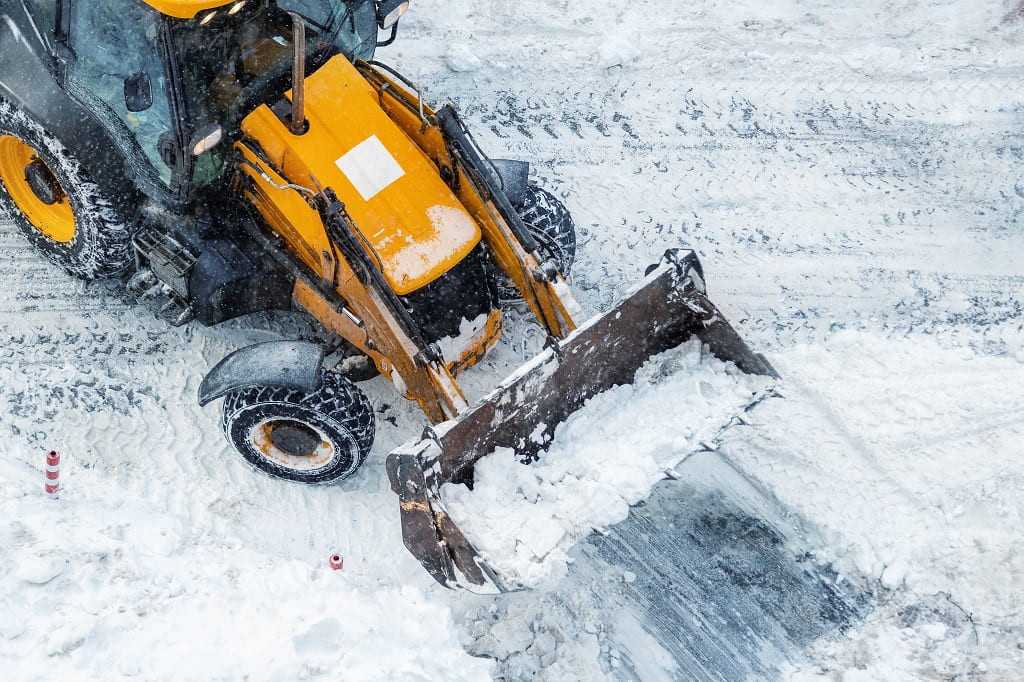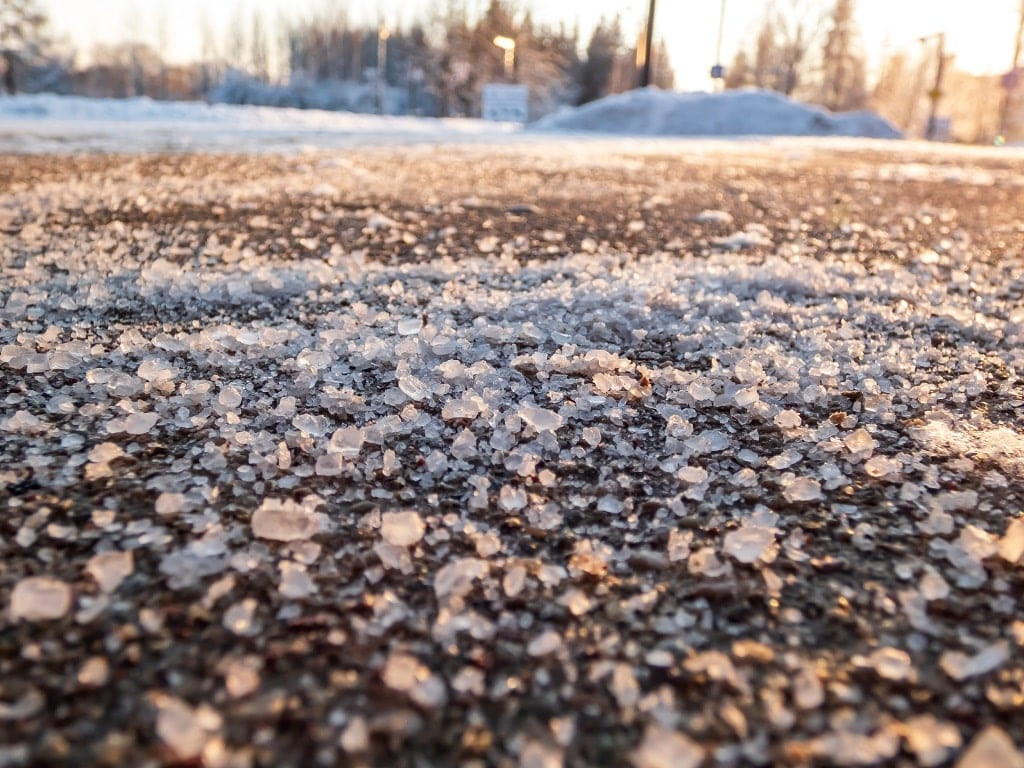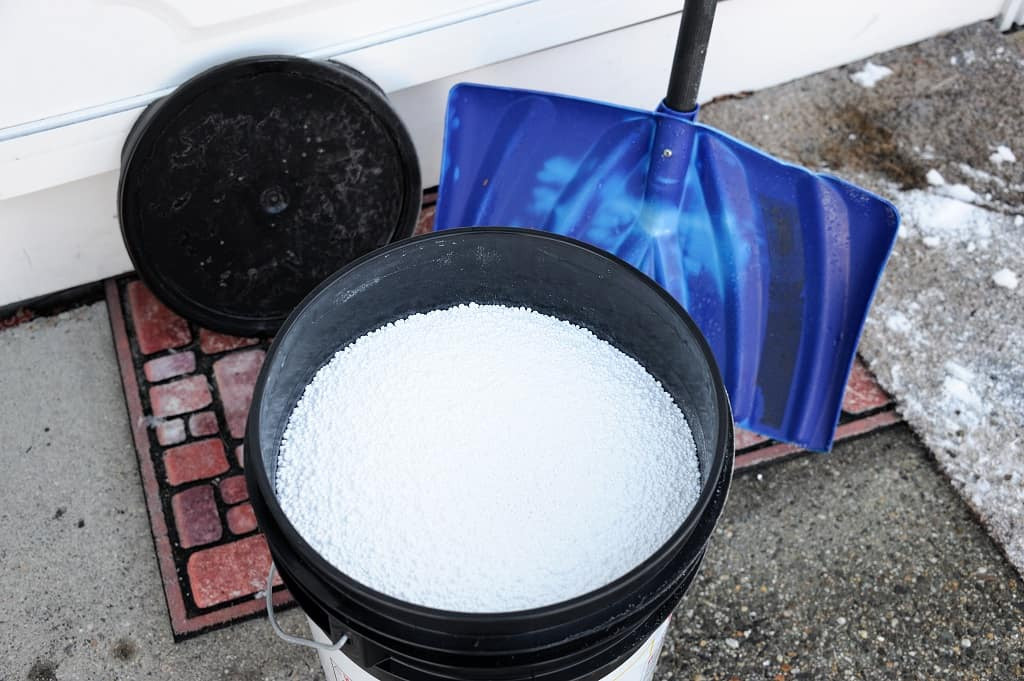Rock salt, a common de-icer, plays a crucial role in winter safety. Should I Put Rock Salt Down Before It Snows? Yes, pre-treating surfaces with rock salt before a snowfall, known as presalting, can significantly improve snow and ice management. This article from rockscapes.net explores the benefits of presalting and postsalting, providing practical tips and guidance for effective winter maintenance. Learn how using rock salt strategically, combined with other winter maintenance techniques, can keep your pathways safe and prevent landscape damage.
1. Why is Pre-Salting Important for Snow and Ice Management?
Pre-salting plays a vital role in effective snow and ice management. Applying rock salt before a snowstorm can create a barrier between the pavement and the snow, preventing ice from bonding to the surface and making snow removal easier. This proactive approach reduces the amount of ice that forms, thereby minimizing hazards.
- Prevents Ice Bonding: Rock salt lowers the freezing point of water, preventing ice from adhering to surfaces.
- Facilitates Easier Removal: A layer of salt beneath the snowpack makes plowing and shoveling more efficient.
- Reduces Hazard: Effective pre-salting decreases the likelihood of slips and falls, ensuring safer conditions.
2. What is the Difference Between Pre-Salting and Post-Salting?
Pre-salting and post-salting are distinct methods used at different times for managing snow and ice. Pre-salting involves applying rock salt before a snowfall to prevent ice from bonding to the pavement. Post-salting, on the other hand, is applying salt after snow removal to melt any remaining ice and prevent refreezing.
| Feature | Pre-Salting | Post-Salting |
|---|---|---|
| Timing | Before snowfall | After snowfall and initial removal |
| Purpose | Prevent ice bonding, ease snow removal | Melt remaining ice, prevent refreezing |
| Effectiveness | Best when applied before the onset of precipitation | Effective after initial snow clearing |
 Pre-salting for snow prevention
Pre-salting for snow prevention
Alt text: Pre-salting application on a road surface before a snowstorm, showing the even distribution of rock salt to prevent ice bonding.
3. What is Pre-Salting?
Pre-salting is a preemptive strategy in winter maintenance that involves spreading rock salt on roads, sidewalks, and other surfaces before a snow or ice storm. This process aims to prevent the formation of a solid bond between the ice and the pavement. By applying salt beforehand, a brine solution forms, which lowers the freezing point of water and minimizes the risk of ice accumulation.
- Proactive Approach: Pre-salting addresses potential ice formation before it occurs.
- Brine Formation: Salt dissolves to create a brine solution that inhibits ice bonding.
- Reduced Ice Accumulation: Effective pre-salting minimizes the buildup of ice, improving safety and ease of removal.
4. When Should You Apply Salt Before a Snowstorm?
Timing is crucial when pre-salting. For optimal results, apply rock salt when the temperature is above freezing but expected to drop, and before the snowfall begins. This allows the salt to dissolve and form a brine solution before the snow starts accumulating.
- Temperature Above Freezing: Salt is most effective when temperatures are above 32°F (0°C).
- Prior to Snowfall: Apply salt at least an hour before the anticipated start of the storm.
- Avoid Heavy Rain: Do not pre-salt if heavy rain is expected, as it can wash away the salt.
5. How Do You Apply Salt for Pre-Salting?
Proper application is critical for pre-salting to be effective. Start by determining the appropriate amount of rock salt needed based on the surface area and weather conditions. Then, use a spreader to distribute the salt evenly across the area. Avoid over-application, which can harm the environment and damage surfaces.
- Calculate Amount: Determine the correct amount of salt based on the area and weather.
- Even Distribution: Use a spreader to apply the salt uniformly.
- Avoid Over-Application: Excessive salt can damage the environment and surfaces.
6. What Types of Salt Products Can Be Used for Pre-Salting?
Various salt products are available for pre-salting, each with different properties and applications. Common options include rock salt (sodium chloride), calcium chloride, magnesium chloride, and potassium chloride.
| Salt Type | Melting Point | Advantages | Disadvantages |
|---|---|---|---|
| Rock Salt (NaCl) | 20°F (-7°C) | Cost-effective, widely available | Less effective at lower temperatures, can corrode metal |
| Calcium Chloride (CaCl2) | -25°F (-32°C) | Effective at very low temperatures, attracts moisture | More expensive, can damage concrete if over-applied |
| Magnesium Chloride (MgCl2) | 5°F (-15°C) | Less corrosive than rock salt, effective at lower temperatures | More expensive than rock salt, can leave a slippery residue |
| Potassium Chloride (KCl) | 25°F (-4°C) | Less harmful to vegetation, environmentally friendly | Less effective at very low temperatures, can be more expensive |
Choosing the right salt product depends on the specific weather conditions and environmental concerns. Rockscapes.net offers a range of options to suit your needs.
7. Tips and Best Practices for Effective Pre-Salting
To maximize the effectiveness of pre-salting, adhere to these best practices:
- Monitor the Weather: Stay informed about upcoming snowstorms and temperature changes.
- Apply Evenly: Use a spreader to ensure uniform coverage.
- Avoid Over-Salting: Too much salt can be detrimental to the environment and surfaces.
- Apply in Advance: Pre-salt at least one hour before the anticipated snowfall.
- Avoid During Rain: Refrain from pre-salting during heavy rainfall to prevent salt runoff.
 Effective pre-salting techniques
Effective pre-salting techniques
Alt text: A close-up of pre-salting showing even distribution of salt granules on pavement to prevent ice formation before a snowstorm.
8. What is Post-Salting?
Post-salting involves applying rock salt after snow has been removed from surfaces through plowing or shoveling. The goal of post-salting is to melt any residual ice or snow and prevent the formation of black ice, which is particularly hazardous.
- Melts Residual Ice: Post-salting targets any remaining ice or snow after initial clearing.
- Prevents Black Ice: It is crucial for preventing the formation of dangerous black ice.
- Improves Traction: Post-salting enhances surface traction, reducing the risk of slips and falls.
9. When is the Best Time for Post-Salting?
Apply rock salt immediately after snow removal, whether by plowing or shoveling. Prompt application prevents any remaining moisture from refreezing and turning into black ice.
- Immediate Application: Apply salt right after clearing the snow.
- Prevents Refreezing: Swift action stops moisture from turning into black ice.
10. How Do You Apply Salt After Snowfall for Post-Salting?
For effective post-salting, calculate the necessary amount of rock salt based on the area and weather conditions. Use a spreader to evenly distribute the salt across the surface. Avoid over-application to minimize environmental impact and surface damage.
- Calculate Amount: Determine the right quantity of salt for the area and conditions.
- Even Distribution: Employ a spreader for uniform coverage.
- Avoid Over-Application: Use salt judiciously to prevent damage.
 Post-salting after snowfall
Post-salting after snowfall
Alt text: Post-salting application on a cleared road surface after snowfall, illustrating the distribution of salt to melt remaining ice and prevent refreezing.
11. What Types of Salt Products Can Be Used for Post-Salting?
Similar to pre-salting, various salt products can be used for post-salting. Common options include rock salt, calcium chloride, magnesium chloride, and potassium chloride. The choice depends on temperature, environmental concerns, and specific needs.
| Salt Type | Melting Point | Advantages | Disadvantages |
|---|---|---|---|
| Rock Salt (NaCl) | 20°F (-7°C) | Cost-effective, widely available | Less effective at lower temperatures, can corrode metal |
| Calcium Chloride (CaCl2) | -25°F (-32°C) | Effective at very low temperatures, attracts moisture | More expensive, can damage concrete if over-applied |
| Magnesium Chloride (MgCl2) | 5°F (-15°C) | Less corrosive than rock salt, effective at lower temperatures | More expensive than rock salt, can leave a slippery residue |
| Potassium Chloride (KCl) | 25°F (-4°C) | Less harmful to vegetation, environmentally friendly | Less effective at very low temperatures, can be more expensive |
Consult rockscapes.net for expert advice on selecting the best product for your specific situation.
12. Tips and Best Practices for Effective Post-Salting
To ensure effective post-salting:
- Apply Promptly: Salt immediately after snow removal.
- Distribute Evenly: Use a spreader for uniform coverage.
- Avoid Over-Application: Use salt sparingly to prevent damage.
- Consider Vegetation: Use caution near plants to avoid harm.
- Store Properly: Keep salt in a dry place to maintain effectiveness.
13. What are the Environmental Considerations When Using Rock Salt?
Using rock salt can have environmental implications. Salt runoff can contaminate soil and water, affecting plant life and aquatic ecosystems. According to research from Arizona State University’s School of Sustainability, excessive salt use in urban areas can lead to increased salinity in local waterways, harming aquatic organisms and vegetation.
- Soil Contamination: Salt can accumulate in the soil, affecting plant health.
- Water Contamination: Runoff can increase salinity in rivers and lakes, harming aquatic life.
- Vegetation Damage: Salt can dehydrate plants, causing damage or death.
To mitigate these effects:
- Use Salt Sparingly: Apply only the necessary amount.
- Consider Alternatives: Explore eco-friendly de-icing options.
- Proper Storage: Store salt properly to prevent runoff.
14. How Does Rock Salt Work to Melt Ice and Snow?
Rock salt works by lowering the freezing point of water. When salt dissolves in water, it forms a brine solution that requires a lower temperature to freeze than pure water. This process disrupts the formation of ice crystals, causing ice and snow to melt.
- Freezing Point Depression: Salt lowers the freezing point of water.
- Brine Formation: Dissolved salt forms a brine solution.
- Crystal Disruption: The brine interferes with ice crystal formation, promoting melting.
15. What are the Safety Precautions to Take When Applying Rock Salt?
When applying rock salt, it’s important to take necessary safety precautions to protect yourself and others.
- Wear Protective Gear: Use gloves and eye protection to prevent skin and eye irritation.
- Use Spreaders: Employ spreaders to ensure even distribution and avoid over-application.
- Clear Pathways: Keep people and pets away from treated areas until the salt has dissolved.
- Store Properly: Store salt in a secure, dry place away from children and pets.
16. What are Some Alternatives to Rock Salt for De-Icing?
Several alternatives to rock salt offer more environmentally friendly options for de-icing:
- Calcium Magnesium Acetate (CMA): Less corrosive and less harmful to vegetation.
- Sand: Provides traction without melting ice, suitable for gravel or unpaved areas.
- Beet Juice: A natural de-icer that lowers the freezing point of water and is biodegradable.
- Urea: Less corrosive than salt but can contribute to nutrient pollution in waterways.
| Alternative | Advantages | Disadvantages |
|---|---|---|
| Calcium Magnesium Acetate | Less corrosive, less harmful to vegetation | More expensive than rock salt, may require more frequent application |
| Sand | Provides traction, suitable for unpaved areas | Does not melt ice, requires cleanup, can clog drains |
| Beet Juice | Biodegradable, lowers freezing point | Can be expensive, may stain surfaces |
| Urea | Less corrosive than salt | Can contribute to nutrient pollution, less effective at very low temperatures |
17. How Do You Store Rock Salt Properly?
Proper storage of rock salt ensures it remains effective and prevents environmental contamination.
- Dry Location: Store salt in a dry, covered area to prevent clumping and dissolving.
- Secure Container: Use a waterproof container to protect salt from moisture.
- Elevated Platform: Place the container on a pallet or platform to avoid ground contact.
- Away from Children and Pets: Keep salt out of reach of children and pets to prevent accidental ingestion.
18. How Much Rock Salt Should You Use for Effective De-Icing?
The amount of rock salt needed depends on several factors, including the temperature, the amount of snow or ice, and the surface area.
- Light Application: For light ice or snow, apply about 1/2 cup of salt per square yard.
- Heavy Application: For heavy ice or snow, apply up to 1 cup of salt per square yard.
- Temperature Considerations: Use more salt at lower temperatures, as it is less effective.
- Follow Guidelines: Refer to the product label for specific application instructions.
19. Can Rock Salt Damage Concrete or Asphalt?
Yes, rock salt can damage concrete and asphalt over time. The salt penetrates the surface and causes it to expand and contract during freeze-thaw cycles, leading to cracks and deterioration.
- Corrosion: Salt corrodes concrete and asphalt.
- Freeze-Thaw Cycles: Expansion and contraction cause cracks.
- Surface Deterioration: Salt accelerates the breakdown of surfaces.
To minimize damage:
- Use Sparingly: Apply only the necessary amount of salt.
- Seal Surfaces: Seal concrete and asphalt to prevent salt penetration.
- Consider Alternatives: Use alternative de-icers that are less corrosive.
20. What are the Benefits of Hiring a Professional Snow Removal Service?
Hiring a professional snow removal service offers several advantages:
- Expertise: Professionals have the knowledge and experience to effectively manage snow and ice.
- Equipment: They use specialized equipment for efficient and thorough removal.
- Safety: Professionals ensure safe conditions, reducing the risk of accidents and injuries.
- Time Savings: Hiring a service saves you time and effort, especially during heavy snowfalls.
- Liability: Professional services carry insurance, protecting you from liability in case of accidents.
For expert advice and services, contact Rockscapes at 1151 S Forest Ave, Tempe, AZ 85281, United States. Phone: +1 (480) 965-9011, or visit our website at rockscapes.net.
21. How Does Climate Change Affect Winter De-Icing Strategies?
Climate change is altering winter weather patterns, leading to more unpredictable and extreme conditions. This affects de-icing strategies in several ways:
- Variable Temperatures: Fluctuating temperatures mean more frequent freeze-thaw cycles, requiring more proactive de-icing.
- Increased Precipitation: Heavier snowfalls necessitate more intensive snow removal efforts.
- Warmer Temperatures: Warmer winters may reduce the overall need for de-icing in some regions but can also lead to more ice storms.
According to the EPA, changes in precipitation patterns and temperatures are making winter weather more variable, which complicates de-icing efforts.
22. What is the Role of Technology in Modern Snow and Ice Management?
Technology plays an increasingly important role in modern snow and ice management:
- Weather Forecasting: Advanced weather models provide more accurate predictions, allowing for timely pre-salting.
- GPS Tracking: GPS tracking systems monitor the location and progress of snow removal equipment.
- Automated Spreaders: Automated spreaders adjust salt application based on real-time conditions.
- Remote Monitoring: Remote sensors monitor pavement temperatures and ice formation, optimizing de-icing efforts.
These technologies improve efficiency, reduce salt usage, and enhance safety.
23. How Can You Minimize Salt Use Without Compromising Safety?
Minimizing salt use is essential for protecting the environment and reducing costs. Strategies include:
- Pre-Treatment: Applying salt before a storm can reduce the amount needed overall.
- Brining: Using salt brine instead of dry salt can improve effectiveness and reduce usage.
- Accurate Application: Calibrating spreaders and using GPS tracking ensure precise application.
- Alternative De-Icers: Considering environmentally friendly alternatives can reduce the impact of salt.
- Proper Plowing: Effective plowing and snow removal minimize the need for de-icing.
24. How Do Different Types of Pavement Affect De-Icing Strategies?
Different types of pavement require different de-icing strategies:
- Concrete: Concrete is more susceptible to salt damage, so minimize usage and seal surfaces.
- Asphalt: Asphalt is more flexible but can still be damaged by salt; use sparingly and consider alternatives.
- Brick and Stone: These surfaces can be particularly vulnerable to salt damage; use alternatives and gentle removal methods.
- Porous Pavement: Porous pavement allows water to drain, reducing the need for de-icing but requires careful management to prevent freeze-thaw damage.
25. What Are the Legal Considerations for Snow and Ice Removal?
Legal considerations for snow and ice removal vary by location but generally include:
- Duty of Care: Property owners have a duty to maintain safe conditions and prevent hazards.
- Slip and Fall Liability: Failure to remove snow and ice can result in liability for injuries.
- Local Ordinances: Many municipalities have ordinances requiring timely snow removal.
- Contractual Obligations: Snow removal contracts outline responsibilities and liabilities.
Consult with local authorities and legal professionals to ensure compliance with applicable laws and regulations.
26. What is the Impact of Pre-Salting on Road Infrastructure?
Pre-salting can have both positive and negative impacts on road infrastructure:
- Reduces Ice Bonding: Prevents ice from bonding, making roads safer and easier to maintain.
- Minimizes Potholes: Reduces the formation of potholes caused by freeze-thaw cycles.
- Corrosion: Salt can corrode metal components of roads, such as bridges and guardrails.
- Concrete Damage: Can damage concrete surfaces, leading to cracking and deterioration.
Effective pre-salting strategies balance the benefits of ice prevention with the need to protect road infrastructure.
27. How Does the Timing of Snowfall Affect Pre-Salting Effectiveness?
The timing of snowfall significantly affects the effectiveness of pre-salting. Applying salt too early can result in it being washed away by rain or scattered by traffic, reducing its impact. Applying it too late, just before the snowfall, might not allow enough time for the salt to dissolve and form a brine solution.
- Ideal Timing: Apply one to two hours before the expected snowfall, allowing the salt to dissolve and create a protective layer.
- Rain Consideration: Avoid pre-salting if rain is expected before the snow, as it will dilute the salt.
- Traffic Impact: Heavy traffic can displace salt, so consider the traffic volume when timing your application.
28. Can Pre-Salting Be Used on Different Types of Surfaces?
Pre-salting can be effective on various surfaces, but the approach may need to be adjusted based on the material.
- Asphalt Roads: Pre-salting is generally effective on asphalt roads, helping to prevent ice bonding and making snow removal easier.
- Concrete Sidewalks: Use caution when pre-salting concrete surfaces, as excessive salt can cause damage over time.
- Brick and Pavers: Pre-salting can be used on brick and paver surfaces, but monitor for any signs of deterioration.
- Wooden Decks: Avoid using salt on wooden decks, as it can accelerate rot and damage.
29. What Types of Equipment Are Used for Pre-Salting?
Various types of equipment can be used for pre-salting, depending on the scale and type of application.
- Walk-Behind Spreaders: Suitable for sidewalks and small areas, these spreaders provide even distribution of salt.
- Truck-Mounted Spreaders: Used for larger areas, such as roads and parking lots, these spreaders can cover a wide area quickly.
- Liquid De-Icing Systems: These systems spray a brine solution onto the pavement, providing effective pre-treatment and reducing salt usage.
- Handheld Spreaders: Small, portable spreaders are useful for spot treatments and hard-to-reach areas.
30. How to Choose the Right De-Icing Salt for Your Needs?
Choosing the right de-icing salt depends on several factors:
- Temperature: Select a salt that is effective at the expected temperatures.
- Environmental Impact: Consider the environmental impact of the salt and choose a more eco-friendly option if possible.
- Surface Type: Choose a salt that is appropriate for the type of surface you are treating.
- Cost: Compare the costs of different salts and choose one that fits your budget.
- Availability: Select a salt that is readily available in your area.
For personalized recommendations and to explore a wide range of options, visit rockscapes.net or contact us at +1 (480) 965-9011.
Final Thoughts: Ensuring a Safe Winter with Strategic Salting
 Pre-salting for winter safety
Pre-salting for winter safety
Alt text: Strategic pre-salting for winter safety, showing a well-treated road surface prepared for an incoming snowstorm.
Effectively pre-salting and post-salting are essential for maintaining safe conditions during winter. By understanding the best practices, choosing the right products, and considering environmental factors, you can minimize hazards and ensure the safety of pedestrians and drivers. Visit rockscapes.net for a comprehensive selection of de-icing products and expert advice on winter maintenance. Contact us at 1151 S Forest Ave, Tempe, AZ 85281, United States, or call +1 (480) 965-9011 to learn more and prepare for the winter season.
FAQ: Pre-Salting and Rock Salt Application
1. Is it better to put salt down before or after snow?
It is generally better to put salt down before snow, known as pre-salting, as it prevents ice from bonding to the pavement and makes snow removal easier. Post-salting is important for melting remaining ice and preventing refreezing.
2. How long before it snows should I put salt down?
Apply salt at least one to two hours before the expected snowfall to allow it to dissolve and create a protective brine layer.
3. What temperature is too cold to put salt down?
Rock salt (sodium chloride) is less effective below 20°F (-7°C). Consider using alternative de-icers like calcium chloride or magnesium chloride at lower temperatures.
4. Can I use rock salt on my concrete driveway?
Use rock salt sparingly on concrete driveways, as excessive use can cause damage over time. Seal the surface to protect it from salt penetration.
5. Is pre-salting environmentally friendly?
Pre-salting can have environmental impacts, so use salt sparingly and consider eco-friendly alternatives.
6. How much rock salt should I use per square foot?
For light ice or snow, apply about 1/2 cup of salt per square yard (approximately 1/18 cup per square foot). For heavy ice or snow, apply up to 1 cup per square yard (approximately 1/9 cup per square foot).
7. What are the alternatives to rock salt for melting ice?
Alternatives include calcium magnesium acetate (CMA), sand, beet juice, and urea.
8. How do I store rock salt properly?
Store rock salt in a dry, covered area in a waterproof container, away from children and pets.
9. Can rock salt damage my plants?
Yes, salt can dehydrate plants and damage them. Use caution when applying salt near vegetation.
10. What equipment do I need for pre-salting and post-salting?
You may need a walk-behind spreader, truck-mounted spreader, liquid de-icing system, or handheld spreader, depending on the scale and type of application.

